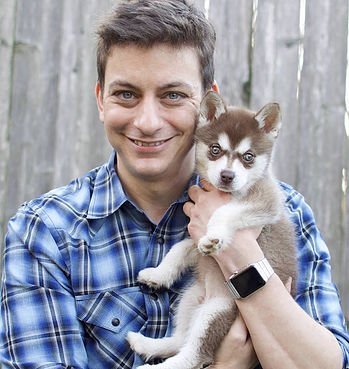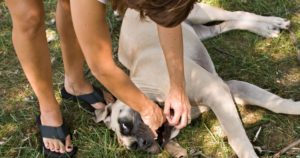If you are struggling with a dog that digs, scratches, chews, bites, and otherwise destroys your stuff or barks non-stop while you’re gone, you’re probably suffering from dog separation anxiety.
Don’t worry, you’re not alone. Dog separation anxiety is one of the most common problems that dog owners suffer from. Dogs don’t always know when (or if) you’re coming back, and this might cause them to act up when you’re not around.
If this sounds like your dog, we’ve put together various resources to help you get this problem under control. We’ve read every article, watched every video, and tried every technique you can think of so that you don’t have to.
Instead, we will summarize our findings below and give you links to more resources if you’d like to dig deeper.

If this sounds like your dog, we’ve put together various resources to help you get this problem under control. We’ve read every article, watched every video, and tried every technique you can think of so that you don’t have to.
Instead, we will summarize our findings below and give you links to more resources if you’d like to dig deeper.

Cesar Millan's Approach to Dog Separation Anxiety
Cesar might be the most well known dog trainer in the world. He has a great in-depth article about dog separation anxiety that is a great read if you have the time.
But if you don’t have time, I’ll summarize it below for you.
Cesar's Do's
- Exercise your dog before you leave
- Teach patience and calmness and reward that
- Teach your pup to love their crate
- Go out of sight for increasing periods of time in your own house
- Teach your dog in small steps to be respectful and have confidence
- Change your routine (use a different door, put your coat and bag in different places)
- Try music and leaving the TV on
Cesar's Don'ts
- Don't use prescription drugs unless absolutely necessary since they tend to be a short-term but not long-term fix
- Don’t leave your house from a door that your dog can see
- Don't talk to your dog or make a big deal about leaving
- Don't make a big deal when you come home
Cesar believes that the root of your dog’s separation anxiety is a human-made behavior that we teach them by making a big deal about leaving and coming home.
Making these events less emotional, starting with us and showing our lack of emotionality to our dogs can help them remain calm when we leave.
Cesar is a huge fan of crate training, and if done properly, crate training can be a very effective way to reduce your dog’s separation anxiety.
Cesar’s approach makes a lot of sense, but is not the only way to deal with separation anxiety. Some people don’t do crate training and still need advice, so let’s look at what some other dog professionals have to say.
Zak George's Approach to Dog Separation Anxiety
Zak believes that many dogs are genetically predisposed to separation anxiety and that it’s hard to fault our dogs for wanting to be with us all the time. It usually means that you have a wonderful bond with them.

Zak's Do's
- Give your dog plenty of mental and physical stimulation
- Figure out the first trigger that clues your dog into your leaving
- Condition your dog to get excited when they see the trigger that you're leaving by using treats and toys
- Associate the sound of your keys jingling with getting a good treat
Zak's Don'ts
- Don't assume it's anxiety when it could be boredom or just youth... it's normal for puppies
- Don't just do the training before you actually leave the house... practice while you're watching TV
- Don't leave them for extended periods at first
Zak has read his research and found that the amount of exercise was the #1 factor for dogs with separation anxiety. One of the easiest fixes Zak recommends is giving your dog a long walk right before you leave.
Zak also suggests using toys and treats to desensitize your dog from triggers like putting your shoes and jacket on. If your dog gets overly excited when you put your jacket on, then put your jacket on in the house randomly and give a treat when the jacket is put on.
That way your dog starts to associate the things that used to trigger anxiety with things that now trigger positive things like treats and toys.
Make sure that your home alone toys are special and only used when you are leaving the house. That will give your dog something to look forward to when you leave.
The Humane Society's Approach to Dog Separation Anxiety
The Humane Society is a great organization that has many resources for helping new dog owners, especially for people who are adopting a dog that might have problems.

The Humane Society's Do's
- Leave your dog with recently worn clothes that smell like you
- Consider using an over-the-counter calming product
- Provide busy toys for distraction
- Take your dog to a doggie daycare. Being in the company of trained, loving human beings as well as other dogs will provide a calming atmosphere.
- Leave your dog with a friend
- Take your dog to work with you
The Humane Society's Don'ts
- Don't make a big deal out of arrivals and departures. Keeping your comings and goings lowkey will help your dog adjust better.
- Avoid punishments. Negative reinforcement can be used for training purposes but can prove detrimental for conditions like anxiety.
- Don't buy another dog to keep the first one company
- Don't use crate training for separation anxiety
- Don't rely on TV/radio noise
What’s interesting about the Humane Society’s advice is that it says to not do many of the things that Cesar Millan recommends doing. Cesar is a big fan of using crate training to reduce separation anxiety, but the Humane Society says that the dog will just stay anxious in its crate and that it doesn’t fix the problem.
I think that the biggest take away here is an open mind. Another thing you should consider is that every dog is different, and what might have worked for a dog that you read about online may not work the same for you. This is especially true for rescued dogs.
For some people and dogs, crate training will help calm their dog down. For others, it won’t. It’s important to watch your dog closely. Maybe setup a dog video camera while you’re away to make sure that your dog isn’t suffering in its crate.

Doggy Dan's Approach to Dog Separation Anxiety
Doggy Dan is another online dog training expert. His approach to dog training is different than Cesar and Zak’s, which is good because not all dogs react the same way to every kind of training, so it’s good to have a different perspective.
Doggy Dan's Do's
- Take control of your dog's environment
- Calmly desensitize your dog through repetition
- Always use a lead when practicing and training
- Use positive reinforcement
- Repeat, repeat, repeat
Doggy Dan's Don'ts
- No yelling or shouting at your dog, as this might worsen his anxiety
- No touching
- Don't lose your cool
What I like about Doggy Dan’s approach is that it is very pro-active and behavior driven. His technique is to actively desensitize your dog by doing activities over and over again, and showing your dog that it’s ok. Showing your dog that nothing bad will happen.
If you want to learn more about this approach, Doggy Dan has a lot of training videos that can step you through this process in more detail.

WebMD's Approach To Dog Separation Anxiety
Like the Humane Society, WebMD has a great resource for people trying to learn to help their dog. Most people don’t realize that WebMD has an entire section of their site dedicated to pet health.
WebMD's Do's
- Give your dog a special treat each time you leave
- Make your comings and goings low-key
- Leave clothes that smell like you
- Consider health supplements.
- Make sure that your dog gets lots of exercise every day. This will keep him happy, improve his appetite, and keep him distracted.
- Play training games and fetch
- Use interactive puzzles to improve your dog's cognitive abilities. This is not only a great developmental method but will also help you bond.
WebMD's Don'ts
- Don't try anything before talking to your vet first and rule out medical problems. You should never self prescribe or administer any medicine to your dog without knowing his pre-existing medical conditions or the way these medications might react with others in your dog's body.
- Don't rush things
- Don't make things worse by yelling and stressing out your dog further. Your dog's anxiety will only worsen if you take it out on him and blame him for his behavior.
Some of the do’s and dont’s between these resources are very different, but many are similar. Here are some of the do’s that keep showing up over and over again:
- Exercise: Almost all of these resources recommend plenty of exercise. Getting enough exercise will keep your dog distracted, make him hungry, and keep him occupied, which is great for both his physical and mental health.
- Toys: Leave special toys that you only use when you leave the house. These toys are a kind of a security measure that will let your dog know that even though you’re not around at that moment, you will be back soon.
- Smells: Put things that remind your dog of your smell. Olfactory anchoring works extremely well for dogs, and leaving some used clothes behind that remind your dog of you will help calm him down and prevent separation anxiety.
The Bottom Line
Dogs really do love their owners unconditionally, and every time you leave the house, even for work, your dog might get anxious that you’re never coming back. While some dogs take this in stride and can handle themselves until you arrive, many dogs go through serious separation anxiety which can affect their long term physical and mental health.
This is especially true if you’re away from home on an extended trip and you’ve left your dog in someone else’s care.
To make this change easier for your dogs, there are some ways in which you can make it easier for your dog to cope with your absence. In this article, we outlined the 5 best alternative approaches to dog separation anxiety that you can try to make life slightly easier for your canine friend.
We hope this article has helped both you and your dog deal with your absence better. If you’re a dog owner and you’re interested in similar topics, feel free to check out our other articles, as well!
The Best Research Links Available for Separation Anxiety for Dogs
- Cesar Millan’s Dog Separation Anxiety
- The Humane Society’s Dog Separation Anxiety
- WebMD’s Dog Separation Anxiety
- Doggy Dan’s Separation Anxiety
- Risk Factors and Behaviors Associated with Separation Anxiety in Dogs
- Early Life Experiences and Exercise Associate with Canine Anxieties
- Diagnostic Criteria for Separation Anxiety in the Dog
- Separation Anxiety in Dogs: The Function of Homeostasis in its Development and Treatment
- The Effect of Time Left Alone at Home on Dog Welfare
- Merck Veterinary Manual – Behavioral Problems of Dogs – Separation Anxiety
- How to Choose the Right Dog Trainer
- APDT Trainer Search






